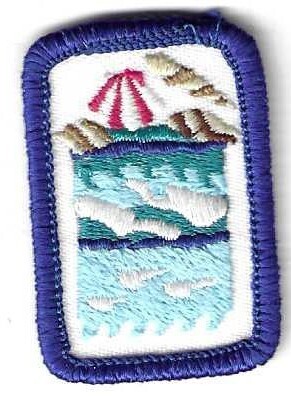High Seas, San Jancinto Council own IP (Original)
Requirements:
GSSJC F-24 10/04 High Seas Girl Scouts of San Jacinto Councils Own Interest Project
Skill Builders
1. What is the maritime industry and who are Merchant Mariners? Find out what role, if any, they play in assisting the United States Armed Services, i.e. Navy, Army. Suggested websites to assist with your research are www.marad.gov, www.socp.org and www.msc.navy.mil.
2. Ships are floating, movable cities. How are they similar to dry land cities? What makes them different (besides being on water)? Make an organization chart of the cruise ship staff and their duties. Be sure to include the captain and his direct staff, as well as the support services that keep guests comfortable and entertained.
3. What are the major parts of a modern ship? Draw a diagram from your own research and label the parts. Compare different types of ships like a tanker, dry cargo, hospital, Navy, research and cruise ships.
4. Some ships carry cargo in their holds or tanks. The weight of the cargo helps keep the ships stable (safe) as they move through the water. How do ships compensate for the missing cargo weight when the holds/tanks are empty? Using what you learn and using a styrofoam cup in a pail of water, demonstrate this principle to another Girl Scout.
5. Steel is a heavy metal and usually sinks in water. Because of the design and the principle of buoyancy, ships built of steel float rather than sink. How does the scientific principle of buoyancy explain this? Experiment with buoyancy in fresh water and salt water using everyday objects around the home. Record your observations.
6. Model shipbuilding is a popular hobby around the world. Select a ship (any type from any time period) and put the model together.
7. Ships can be floating hospitals. What types of services are offered on a hospital ship? Is this a full service hospital? What organizations have such ships? Create a scrapbook for a troop of younger Girl Scouts, showing a hospital ship and some of the activities onboard, including the operating amphitheatre, the wards, and how critically ill patients are taken to land-based care facilities.
Technology
1. Visit a Maritime Museum and research the history of the whaling industry.
2. With no landmarks out at sea, it is very difficult to determine what direction you are traveling. All ships’ deck officers must know how to determine direction at sea by using gyrocompasses and magnetic compasses. What is the difference between a gyrocompass and a magnetic compass? What is meant by “dead reckoning”? Why does a ship need radar equipment?
3. Because ships travel through and float on the water, they are affected by the wind and by the currents of the sea. What kinds of effects do the wind and sea currents have on a ship? Hold a toy sailboat regatta in a wading pool filled with water with other members of your troop. Practice blowing from different directions on your boats’ “sails” to see which way they go. Watch the drift of the boats when no wind is applied. Is there a pattern?
4. The land places where ships load or unload their cargoes are called ports. What makes a location a good site for a port? Are all ports located on the coast? What do modern ports offer to make distribution of the ship's goods to market efficient? Take a driving or boat tour of a local port. Look for technology in action.
5. A ship cannot turn on a TV to view a local weather forecast. So, the National Oceanographic and Atmospheric Administration (NOAA), the U. S. government weather people, provide Marine Weather Forecasts to ships and boats. NOAA provides weather information on their web site. If a ship cannot connect to the internet, how else do they receive NOAA forecasts? Visit NOAA’s website and track the weather for a period of 3 consecutive days.
Service
1. A Seamen's Center meets the needs of ship crews in foreign ports. Learn more about a local Seamen's Center (see their website). Participate in a Seamen's Center sponsored service project.
2. Create a game for younger girls using the maritime knowledge gained in the Skill Builders or Technology section of this interest project. Introduce them to geography, countries, land forms, navigable waters, economy, science, technology, etc.
3. Contact a maritime group that can connect you or your troop/group to a ship and its crew. Chart their course over a period of time and learn about their ports of call. Send letters or emails to the crew. Visit the website “Follow the Voyage”. If possible send small gifts you or your troop/group have made. [Remember to follow Safety-Wise rules for pen pals.]
4. Create a treasure hunt for younger girls to help them learn nautical and orienteering skills. Be creative.
Careers
1. Learn about college degree programs in maritime.
2. Contact a cruise line and find out what types of employment are offered. If possible, tour the behind the scenes area of a ship.
3. Contact your local armed service recruiter to find out what naval or marine careers they offer. Are there jobs in the armed forces that give beneficial experiences for a civilian job later?
4. What is the Coast Guard? What is its role in peacetime or during conflict? What types of skills are needed?
5. Is a degree in the hotel and hospitality industry compatible with a ship? Find out what schools offer degrees in this area.
6. Attend a maritime career day. Make a list of careers available. Were there any surprises? What is the pay scale for an entry level position? What does a naval architect do?
